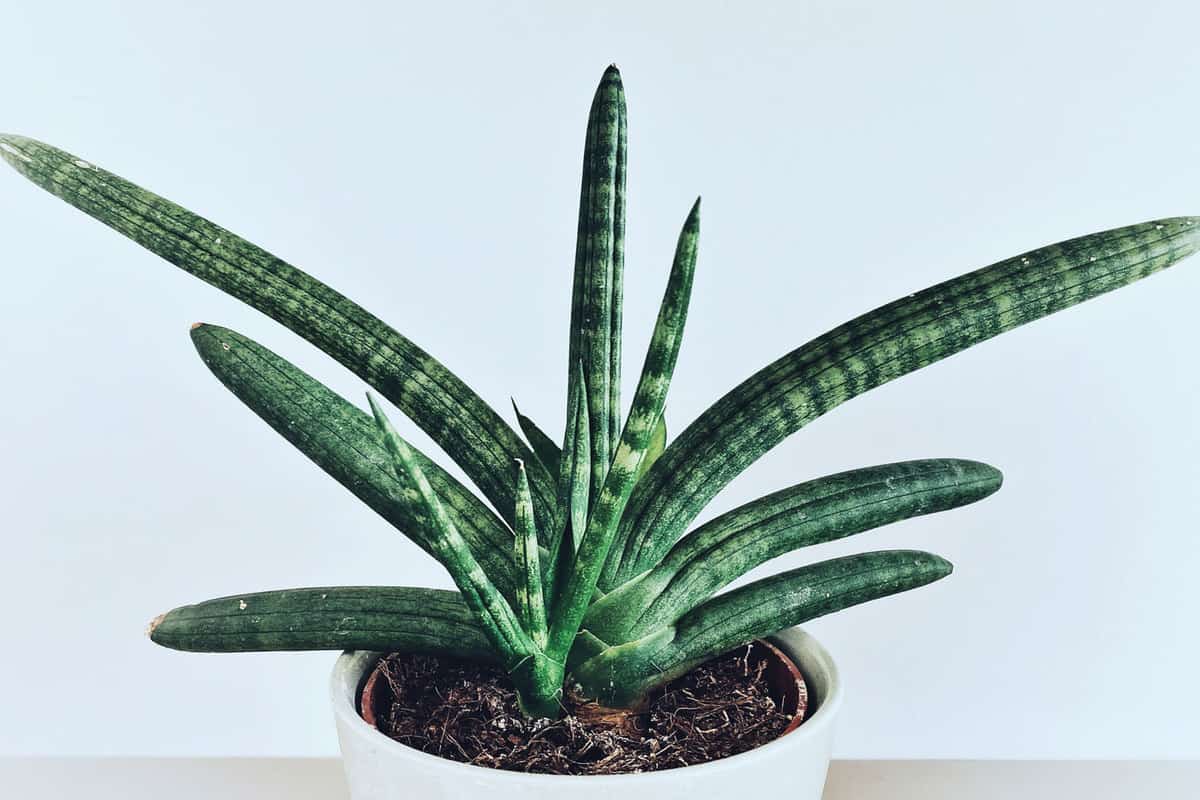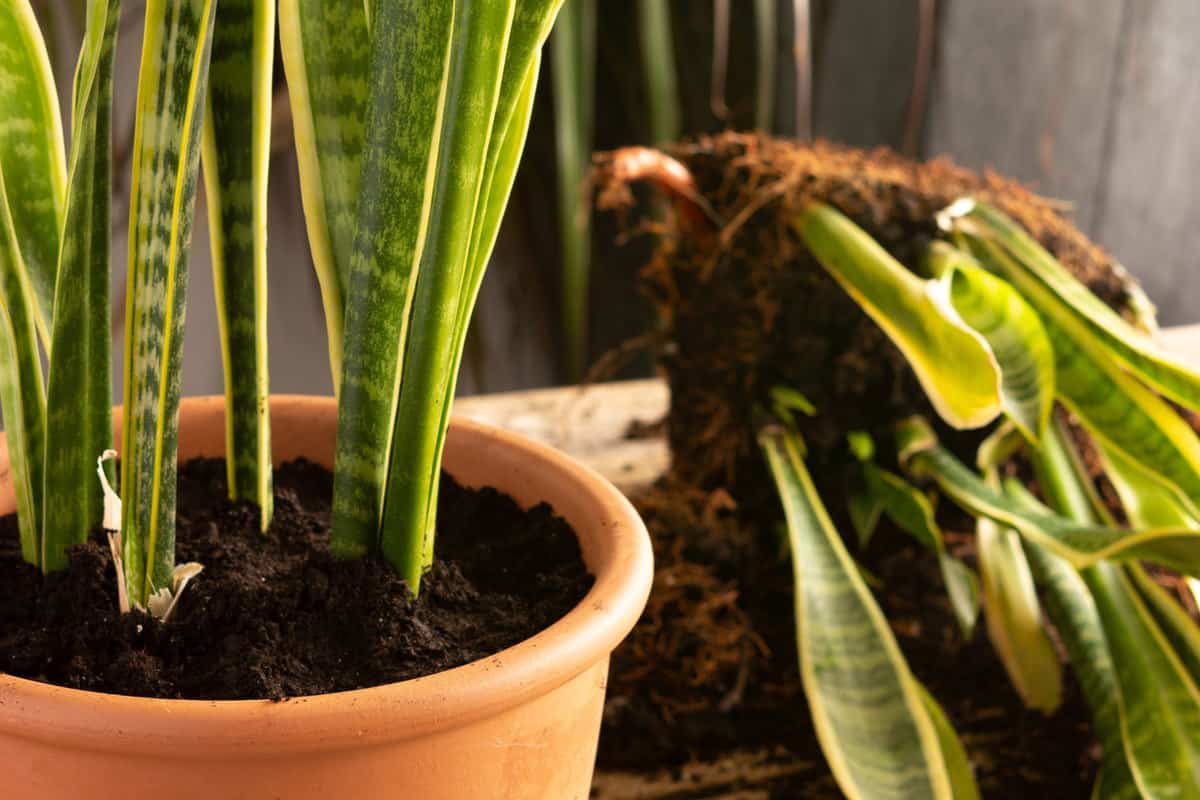Snake plants, also known as mother-in-law's tongue, are hardy plants perfect for people with a "brown thumb." However, one of the plant's primary offenders is root rot. The good news is, root rot is easy to prevent with the right soil and container. We researched the best soil for snake plants to make sure you have everything you need.
Snake plants need free-draining soil to prevent root rot. So cactus, succulent, or palm soils are usually a good choice. If you plan to use standard planting soil, you can use additives like perlite, coco coir, and sand to improve drainage.
Let's take a closer look at picking a propper soil and pot to make your snake plant thrive.

The Best Soil for Snake Plants
Snake plants are prone to root rot, so well-draining soil is needed. Otherwise, snake plants are pretty easy going when it comes to their soil.
Some people also use a "soilless" medium for snake plants. That is usually a mix of sand, sphagnum or peat moss and pearlite. There are a ton of different mixes and recipes to choose from.
Even though they are not ideal, your snake plant will happily grow in regular potting soil. If you are using a standard potting soil and have the resources, it is excellent to amend it for drainage. Sand is a popular option, but you can also mix in pearlite, coco coir, or almost anything that would aid in preventing root rot.
Regardless of the mix you go with, snake plants are hardy and forgiving. So as long as you are managing water correctly, your snake plant will probably happily grow.
Soil is a bit more concerning if you are placing a snake plant in an outside garden. If you are, make sure to break up the soil well beforehand. If you have a natural clay loam, you can dig in and break up the clay, then mix in some sand to help the soil drain.
Soil pH
Soil pH is not a major ordeal for snake plants as they can tolerate anything from a 5 to an 8.5 pH level. Slightly acidic soil, around 5.5 or 6 pH is ideal.
Slightly acidic soil is ideal for many plants, so any soil you buy will usually be made with that in mind. If you are concerned about the soil pH in your garden, you can have a soil test done or run a pH test at home.
Soil pH becomes more of a concern if you are hydroponically growing plants. If you are, make sure not to put in a lot of acidic liquids like coffee. If you are putting the snake plants with pebbles, it is also good to wash them off first to make sure there are no harmful residues on them.
Can You Use Cactus Soil For Snake Plants?

Yes, you can use cactus soil for snake plants. Cactus soil is made to have good drainage, so it is great for snake plants. Like snake plants, cacti are prone to root rot, and their soil usually contains elements to help keep the plants from getting "wet feet."
Cactus soil also usually contains a fair bit of sand, which snake plants enjoy.
Cactus or palm soil is an excellent option if you don't want to mix your own soil. If you do not want to use a ton of cactus soil, you can also mix it as an amendment with normal potting soil to improve drainage.
The Best Containers for Snake Plants
Snake plants' container is also important. Terra cotta pots and smart pots are suitable for snake plants because they have good drainage and ample airflow.
Snake plants also do not need a huge pot, depending on how many you want in a single container. Usually, having a three-gallon pot or smaller is good. Much more, and it is probably a bit too much space.
If you think you will need more space eventually, start with a small pot and transplant later. Snake plants do not mind being somewhat root-bound as long as the roots do not begin circling.
Smart pots, also known as felt pots, air prune roots. Air pruning helps plants grow oxygenated and healthy roots.
Their fabric material also makes it harder to overwater the plants. However, it is still important to water your snake plant properly.
By air pruning and allowing for good drainage, they are an excellent choice for snake plants.


Click here to see this three-gallon smart pot on Amazon.
Preventing Root Rot

Root rot is a common plant disease where the roots of the plant begin to rot away. Symptoms of root rot include slow growth, brown leaves, and weak or decaying branches.
Using appropriately draining soil and containers are the best steps to take in preventing this disease. Snake plants are especially prone to this disease, so if you are anxious, you can do some other things to help prevent root rot.
Probably the easiest step in preventing root rot is to water correctly. Before watering the plant, put your finger an inch or two into the soil. If the soil is damp, wait another day or two before watering it.
In the winter, snake plants usually enter dormancy, and their growth slows. It is essential to space out watering more to prevent over-saturation.
Another useful trick is to use a sponge to help separate the water from the roots. Not only does using the sponge trick help prevent root rot, but it can also help make it easier to maintain a healthy watering.
Is Peat Moss Good For Snake Plants?
Sphagnum moss or peat moss is suitable for snake plants as they allow for creation and good drainage. Similar soil additions like coco coir are also good ideas.
Peat moss is best used as a soil amendment and not to make up most of the soil. Depending on the soil composition, peat moss should not make up much more than 20 percent of the soil. You want the soil to retain some water, just not enough to cause root rot. Take the overall soil drainage into account when making amendments.
If it will add to the good drainage of the soil, it is good for snake plants.
Can Snake Plants Grow Without Soil?
Yes, snake plants can grow without soil. They grow well in soil-less mediums, but snake plants will not thrive when grown only in water.
Snake plants can grow for a while in pebbles or other mediums. However, they usually will not grow as big as they potentially could. However, if you are trying to keep a small snake plant on your desk, it may be a good option for you.
If you decide to try growing a snake plant hydroponically, you can also use a soluble fertilizer to promote growth. Just make sure to change the water out regularly, especially with transparent containers.
If you are looking to root snake plants in water, then transfer them to a pot with soil. That should work. You could also use a rooting hormone to root snake plants directly in the soil.
Further Reading
Want to learn more about soil and the right soil for different plants? Take a look at these other informative posts to help you and your plants thrive!
What’s the Best Soil For Sunflowers?

Please send me free copy of your “Garden Tools Cheat Sheet and any information to help me with other plants.
Thank you very much,
Please scroll down the main page [https://gardentabs.com/], and you’ll see the SUBSCRIBE button. If you haven’t subscribed to our newsletter, click here: https://gardentabs.com/gardentabs-newsletter/